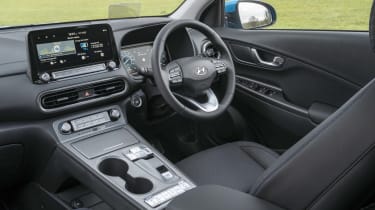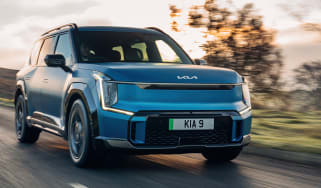Hyundai Kona Electric (2018-2023) review
The Hyundai Kona Electric boasts smart looks, reasonable pricing and – crucially – a range that meets or beats that offered by many rivals
Pros
- Up to 300-mile range
- Fashionable crossover styling
- Well equipped for the asking price
Cons
- Interior a bit bland
- Some rivals more spacious
- Weight saps driving enjoyment
|
Battery size |
Official range |
Wallbox charge time |
Rapid charge time |
|
39kWh |
189 miles |
6hrs (0-100%, 7.4kW) |
48mins (10-80%, 50kW) |
|
64kWh |
300 miles |
9hrs 15mins (0-100%, 7.4kW) |
47mins (10-80%, 100kW) |
The Hyundai Kona has been offered in various forms across the years, from diesel to hybrid, but this fully electric version is by far the best of the bunch. While the others are only midfield contenders in their class, the zero-emissions Kona has long been one of best electric family cars on the market – and it still is, even after the arrival of the all-new, second-generation model.
The Kona Electric was facelifted in 2021, but the two battery options were unchanged. It’s no longer available to order from new, but Hyundai says there are still some new cars available from stock – make sure to check with your local dealer.
The entry-level car has a 39kWh battery and 134bhp motor, while the range-topper features a 64kWh battery and 201bhp motor. The latter is vastly more popular, but the 39kWh version's lower price may appeal to some who primarily want a car for shorter local journeys.
With a 7.4kW home wallbox fitted, charging even the larger-battery Kona Electric at home should take less than 10 hours. On long-distance trips, you’ll likely be using rapid-charging stations at motorway services, and these can give the Kona Electric an 80% top-up in less than an hour. Maximum range stands at between 189 and 300 miles depending on which battery you opt for.
So which spec should you go for? Even the entry-level SE Connect is well equipped, with 17-inch alloy wheels, roof rails, adaptive cruise control, electric windows and a 10.25-inch touchscreen with sat nav and smartphone connectivity, as well as a comprehensive safety package – although it's only available with the smaller 39kWh battery.
Premium trim is available with both battery sizes and adds luxuries like heated seats, wireless phone charging and LED headlights and is our pick of the lineup. Ultimate tops the range with a head-up display, plus ventilated front seats and a sunroof – although it's only available with the larger 64kWh battery.
On the road, the Kona Electric feels similar to its combustion-engined siblings, which means it’s not much fun to drive, but never less than competent. The electric version is more relaxing, as it’s so quiet and you don’t have the hassle of changing gear, but the considerable extra weight makes itself felt on twisty roads and when you’re accelerating. The 64kWh version will do 0-62mph in 7.6 seconds, but never feels like a hot hatchback; top speed is 104mph. The ride is comfortable, though, which adds to the relaxing feel.
From a practicality perspective, the Kona isn’t as spacious or well thought-out as some of its rivals, particularly the Niro EV, and the boot may feel pretty small to some users. But the Hyundai is just about big enough to manage a family of four, and it has a good safety rating, too.
Click here to see why you can trust DrivingElectric reviews, or for a more detailed look at the Hyundai Kona Electric, read on for the rest of our in-depth review...




